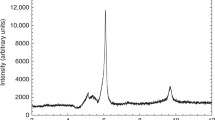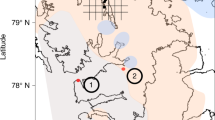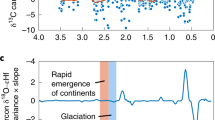Abstract
The rise of atmospheric oxygen during the Great Oxidation Event some 2.4 billion years ago was a defining transition in the evolution of global biogeochemical cycles and life on Earth. However, mild oxidative continental weathering and the development of ocean oxygen oases occurred several hundred million years before the Great Oxidation Event. The Great Oxidation Event thus represents a tipping point, whereby primary productivity and O2 production overwhelmed the input of reduced species that consume O2, and its timing is determined by the input of phosphate, the major limiting nutrient, and the dynamics of the solid Earth. Here, we determine the phase partitioning of phosphorus in 2.65 to 2.43 billion year old drill core samples from the Transvaal Supergroup, South Africa, to investigate the sequence of events that facilitated persistent atmospheric oxygenation. On the basis of the elevated C/P ratios found within sulfidic sediments, relative to the Redfield ratio, we suggest that, as oxidative continental weathering increased the influx of dissolved sulfate and hence dissolved sulfide in the oceans, bioavailable phosphorus became more abundant due to anoxic recycling of sedimentary phosphorus phases. Biogeochemical modelling indicates that this initiated a positive feedback on primary productivity and shows that the evolution of phosphorus recycling may have been a critical step that enabled Earth’s transition to a persistently oxygenated atmosphere.




Similar content being viewed by others
Data availability
The geochemical dataset is available at https://doi.org/10.6084/m9.figshare.14186114.
Code availability
Model code and output data are available from the corresponding author on reasonable request.
References
Anbar, A. D. et al. A whiff of oxygen before the Great Oxidation Event? Science 317, 1903–1906 (2007).
Kendall, B. et al. Pervasive oxygenation along late Archean ocean margins. Nat. Geosci. 3, 647–652 (2010).
Ostrander, C. M. et al. Fully oxygenated water columns over continental shelves before the Great Oxidation Event. Nat. Geosci. 12, 186–191 (2019).
Ossa Ossa, F. et al. Limited oxygen production in the Mesoarchean ocean. Proc. Natl Acad. Sci. USA 116, 6647–6652 (2019).
Poulton, S. W. & Canfield, D. E. Ferruginous conditions: a dominant feature of the ocean through Earth’s history. Elements 7, 107–112 (2011).
Canfield, D. E. The early history of atmospheric oxygen: homage to Robert M. Garrels. Annu. Rev. Earth Planet. Sci. 33, 1–36 (2005).
Reinhard, C. T., Raiswell, R., Scott, C., Anbar, A. D. & Lyons, T. W. A late Archean sulfidic sea stimulated by early oxidative weathering of the continents. Science 326, 713–716 (2009).
Scott, C. T. et al. Late Archean euxinic conditions before the rise of atmospheric oxygen. Geology 39, 119–122 (2011).
Poulton, S. W. Early phosphorus redigested. Nat. Geosci. 10, 75–76 (2017).
Tyrrell, T. The relative influences of nitrogen and phosphorus on oceanic primary production. Nature 400, 525–531 (1999).
Bjerrum, C. J. & Canfield, D. E. Ocean productivity before about 1.9 Gyr ago limited by phosphorus adsorption onto iron oxides. Nature 417, 159–162 (2002).
Reinhard, C. T. et al. Evolution of the global phosphorus cycle. Nature 541, 386–389 (2017).
Guilbaud, R. et al. Phosphorus-limited conditions in the early Neoproterozoic ocean maintained low levels of atmospheric oxygen. Nat. Geosci. 13, 296–301 (2020).
Krom, M. D. & Berner, R. A. The diagenesis of phosphorus in a nearshore marine sediment. Geochim. Cosmochim. Acta 45, 207–216 (1981).
Ingall, E. D., Bustin, R. M. & Van Cappellen, P. Influence of water column anoxia on the burial and preservation of carbon and phosphorus in marine shales. Geochim. Cosmochim. Acta 57, 303–316 (1993).
Ingall, E. & Jahnke, R. Evidence for enhanced phosphorus regeneration from marine sediments overlain by oxygen depleted waters. Geochim. Cosmochim. Acta 58, 2571–2575 (1994).
Ruttenberg, K. C. & Berner, R. A. Authigenic apatite formation and burial in sediments from non-upwelling, continental margin environments. Geochim. Cosmochim. Acta 57, 991–1007 (1993).
Xiong, Y. et al. Phosphorus cycling in Lake Cadagno, Switzerland: a low sulfate euxinic ocean analogue. Geochim. Cosmochim. Acta 251, 116–135 (2019).
Dijkstra, N., Kraal, P., Kuypers, M. M., Schnetger, B. & Slomp, C. P. Are iron-phosphate minerals a sink for phosphorus in anoxic Black Sea sediments? PLoS ONE 9, e101139 (2014).
Van Cappellen, P. & Ingall, E. D. Benthic phosphorus regeneration, net primary production, and ocean anoxia: a model of the coupled marine biogeochemical cycles of carbon and phosphorus. Paleoceanography 9, 677–692 (1994).
Kump, L. R. & Barley, M. E. Increased subaerial volcanism and the rise of atmospheric oxygen 2.5 billion years ago. Nature 448, 1033–1036 (2007).
Greber, N. D. et al. Titanium isotopic evidence for felsic crust and plate tectonics 3.5 billion years ago. Science 357, 1271–1274 (2017).
Lee, C.-T. A. et al. Two-step rise of atmospheric oxygen linked to the growth of continents. Nat. Geosci. 9, 417–424 (2016).
Catling, D. C., Zahnle, K. J. & McKay, C. P. Biogenic methane, hydrogen escape, and the irreversible oxidation of early Earth. Science 293, 839–843 (2001).
Alcott, L. J., Mills, B. J. W. & Poulton, S. W. Stepwise Earth oxygenation is an inherent property of global biogeochemical cycling. Science 366, 1333–1337 (2019).
Zerkle, A. L., Claire, M. W., Domagal-Goldman, S. D., Farquhar, J. & Poulton, S. W. A bistable organic-rich atmosphere on the Neoarchean Earth. Nat. Geosci. 5, 359–363 (2012).
Hardisty, D. S. et al. An evaluation of sedimentary molybdenum and iron as proxies for pore fluid paleoredox conditions. Am. J. Sci. 318, 527–556 (2018).
Thompson, J. et al. Development of a modified SEDEX phosphorus speciation method for ancient rocks and modern iron-rich sediments. Chem. Geol. 524, 383–393 (2019).
Bekker, A. et al. in Treatise on Geochemistry Vol. 9 (eds Holland, H. and Turekian, K.) 561–628 (Elsevier, 2013).
Gumsley, A. P. et al. Timing and tempo of the Great Oxidation Event. Proc. Natl Acad. Sci. USA 114, 1811–1816 (2017).
Bekker, A. & Holland, H. D. Oxygen overshoot and recovery in the early Paleoproterozoic. Earth Planet. Sci. Lett. 317–318, 295–304 (2012).
Bindeman, I. N. et al. Rapid emergence of subaerial landmasses and onset of a modern hydrologic cycle 2.5 billion years ago. Nature 557, 545–548 (2018).
Cox, G. M., Lyons, T. W., Mitchell, R. N., Hasterok, D. & Gard, M. Linking the rise of atmospheric oxygen to growth in the continental phosphorus inventory. Earth Planet. Sci. Lett. 489, 28–36 (2018).
Kharecha, P., Kasting, J. F. & Siefert, J. A coupled atmosphere–ecosystem model of the early Archean Earth. Geobiology 3, 53–76 (2005).
Olson, S. L., Kump, L. R. & Kasting, J. F. Quantifying the areal extent and dissolved oxygen concentrations of Archean oxygen oases. Chem. Geol. 362, 35–43 (2013).
Hao, J., Knoll, A. H., Huang, F., Hazen, R. M. & Daniel, I. Cycling phosphorus on the Archean Earth: part I. Continental weathering and riverine transport of phosphorus. Geochim. Cosmochim. Acta 273, 70–84 (2020).
Krissansen-Totton, J., Arney, G. N. & Catling, D. C. Constraining the climate and ocean pH of the early Earth with a geological carbon cycle model. Proc. Natl Acad. Sci. USA 115, 4105–4110 (2018).
Daines, S. J., Mills, B. J. W. & Lenton, T. M. Atmospheric oxygen regulation at low Proterozoic levels by incomplete oxidative weathering of sedimentary organic carbon. Nat. Commun. 8, 14379 (2017).
Shields, G. A. et al. Unique Neoproterozoic carbon isotope excursions sustained by coupled evaporite dissolution and pyrite burial. Nat. Geosci. 12, 823–827 (2019).
Schröder, S. Stratigraphic and geochemical framework of the Agouron drill cores, Transvaal Supergroup (Neoarchean–Paleoproterozoic, South Africa). S. Afr. J. Geol. 109, 23–54 (2006).
Schröder, S., Bedorf, D., Beukes, N. J. & Gutzmer, J. From BIF to red beds: sedimentology and sequence stratigraphy of the Paleoproterozoic Koegas Subgroup (South Africa). Sediment. Geol. 236, 25–44 (2011).
Trendall, A. F. et al. Precise zircon U/Pb chronological comparison of the volcano–sedimentary sequences of the Kaapvaal and Pilbara cratons between about 3.1 and 2.4 Ga. In Proc. Third International Archean Symposium (eds Glover, J. E & Ho, S. E.) 81–83 (1990).
Lantink, M. L., Davies, J. H. F. L., Mason, P. R. D., Schaltegger, U. & Hilfen, F. J. Climate control on banded iron formations linked to orbital eccentricity. Nat. Geosci. 12, 369–374 (2019).
Gutzmer, J. & Beukes, N. J. High-Grade Manganese Ores in the Kalahari Manganese Field: Characterisation and Dating of Ore-Forming Events. Unpublished Report. Rand Afrikaans University (1998).
Havig, J. R., Hamilton, T. L., Bachan, A. & Kump, L. R. Sulfur and carbon isotopic evidence for metabolic pathway evolution and a four-stepped Earth system progression across the Archean and Paleoproterozoic. Earth Sci. Rev. 174, 1–21 (2017).
Johnson, J. E. et al. Manganese-oxidizing photosynthesis before the rise of cyanobacteria. Proc. Natl Acad. Sci. USA 110, 11238–11243 (2013).
Poulton, S. W. & Canfield, D. E. Development of a sequential extraction procedure for iron: implications for iron partitioning in continentally derived particulates. Chem. Geol. 214, 209–221 (2005).
Canfield, D. E., Raiswell, R., Westrich, J. T., Reaves, C. M. & Berner, R. A. The use of chromium reduction in the analysis of reduced inorganic sulfur in sediments and shales. Chem. Geol. 54, 149–155 (1986).
Poulton, S. W., Fralick, P. W. & Canfield, D. E. Spatial variability in oceanic redox structure 1.8 billion years ago. Nat. Geosci. 3, 486–490 (2010).
Doyle, K. A., Poulton, S. W., Newton, R. J., Podkovyrov, V. N. & Bekker, A. Shallow water anoxia in the Mesoproterozoic ocean: evidence from the Bashkir Meganticlinorium, Southern Urals. Precambrian Res. 317, 196–210 (2018).
Tosca, N. J., Guggenheim, S. & Pufahl, P. K. An authigenic origin for Precambrian greenalite: implications for iron formation and the chemistry of ancient seawater. GSA Bull. 128, 511–530 (2016).
Clarkson, M. O., Poulton, S. W., Guilbaud, R. & Wood, R. A. Assessing the utility of Fe/Al and Fe-speciation to record water column redox conditions in carbonate-rich sediments. Chem. Geol. 382, 111–122 (2014).
Strickland, J. D. H. & Parsons, T. R. A Practical Handbook of Seawater Analysis 2nd edn (Fisheries Research Board of Canada, 1972).
Claire, M. W., Catling, D. C. & Zahnle, K. J. Biogeochemical modelling of the rise in atmospheric oxygen. Geobiology 4, 239–269 (2006).
Kraal, P., Slomp, C. P., Forster, A. & Kuypers, M. M. M. Phosphorus cycling from the margin to abyssal depths in the proto-Atlantic during oceanic anoxic event 2. Palaeogeogr. Palaeoclimatol. Palaeoecol. 295, 42–54 (2010).
Acknowledgements
L.J.A. was funded by a Leeds Anniversary Research Scholarship. S.W.P. acknowledges support from a Leverhulme Research Fellowship and a Royal Society Wolfson Research Merit Award. S.W.P. and B.J.W.M. acknowledge financial support from NERC (NE/R010129/1). Participation of A.B. was made possible with funding from NSERC Discovery and Accelerator grants.
Author information
Authors and Affiliations
Contributions
S.W.P., L.J.A., B.J.W.M. and A.B. designed the research and collected the samples. L.J.A. and S.W.P. performed geochemical analyses and interpreted the data. B.J.W.M. guided the biogeochemical modelling, and A.B. provided geological context. All authors contributed to writing the manuscript.
Corresponding author
Ethics declarations
Competing interests
The authors declare no competing interests.
Peer review
Peer review information
Nature Geoscience thanks Dominic Papineau and the other, anonymous, reviewer(s) for their contribution to the peer review of this work. Primary Handling Editor: Rebecca Neely, in collaboration with the Nature Geoscience team.
Additional information
Publisher’s note Springer Nature remains neutral with regard to jurisdictional claims in published maps and institutional affiliations.
Supplementary information
Supplementary Information
Supplementary Figs. 1–12, Tables 1–4 and discussion to support interpretations.
Rights and permissions
About this article
Cite this article
Alcott, L.J., Mills, B.J.W., Bekker, A. et al. Earth’s Great Oxidation Event facilitated by the rise of sedimentary phosphorus recycling. Nat. Geosci. 15, 210–215 (2022). https://doi.org/10.1038/s41561-022-00906-5
Received:
Accepted:
Published:
Issue Date:
DOI: https://doi.org/10.1038/s41561-022-00906-5
- Springer Nature Limited
This article is cited by
-
A phosphate-rich marine reservoir in the redox stratified Ediacaran ocean
Communications Earth & Environment (2024)
-
Crustal carbonate build-up as a driver for Earth’s oxygenation
Nature Geoscience (2024)
-
Clay minerals store organic carbon and cool Earth’s climate over millions of years
Nature Geoscience (2024)
-
Biogeochemistry of Earth before exoenzymes
Nature Geoscience (2023)
-
Uncovering the Ediacaran phosphorus cycle
Nature (2023)





